
Oh midcentury modern, why do you have to look so cool and yet be so uncomfortable? The 1950s-era chic has been back for the last five years or so, and it’s starting to infiltrate offices. Our clients are starting to ask for lean, rectangular desks for reasons of both form and function. They believe the horizontal lines look more contemporary, and they think they can fit more desks in a room. What they’re not thinking about is comfort.
When I say comfort, of course, I mean ergonomics. You spend a lot of time at your desk, so it should fit you and be suited to your work. I don’t buy the premise that rectangular desks look cooler, and I can certainly prove that they take up more—not less—space than curved desks. Let me explain my preference for curved desks, also referred to as cockpit-shape or L-shape desks.

Think of your workstation as your sofa at work. Which sofa would you rather spend more time on?
1. Maximum Reach Zones
As I stand at my curved desk, I take a look around and appreciate the ergonomics. First, everything I really need—my computer, phone, keyboard and mouse—is within arm’s reach in my primary reach zone. (Sweep your forearm horizontally across your work surface to establish your primary reach zone. Movements within this area are faster and more accurate while protecting your arms and wrists.)
With the wraparound shape of the desk, the few other things I need—notebook, pen, Post-It notes—are in the secondary reach zone. I tuck a few reference books in the terteriary zone, and I still have space on the sides to review documents and eat my lunch. With this setup, I can reach all my work supplies with slight movements. At a straight desk with similar real estate, I’d be walking or rolling all over the place. Learn more about reach zones here.

2. Proper Focal Depth
Like most of you, I use multiple monitors. With a curved desk, I can easily place all my monitors at the proper focal distance whether I’m sitting or standing. And I know from experience that this is important to prevent the eyestrain, headaches and neck pain that can result from straining to see monitors. Plus, the curved front edge of the curved desk lets me lean in close when necessary.
You can read details on focal depth here, but for a quick summary: Place screens roughly 20” to 40” from your eyes, align the top ¼ of the screen with your eyes so you can gaze down 15° to 20° from level, and make sure multiple screens are less than 35° off axis from your predominant line of sight. A curved workstation allows for more consistent placement of screens so they are equal distance from the eyes. As the screens wrap around you, keeping the distance equal from one screen to the next will reduce the eye strain of focal changes.
3. Wiggle Room
Even though we recommend alternating sitting and standing throughout the day, I’m a stander. But when I do need to sit down and kick back at my desk, I need leg room. I can’t be kicking the trash can or getting my foot stuck in my backpack strap. Curved desks provide ample room for your legs even if you’re sharing space with a CPU, small filing cabinet and personal items. With a straight desk, you might even be kicking a wall. You can learn more about the importance of leg room here.
4. Conserve Space in the Room Layout
If you’ve ever played with Legos or played Tetris, you know how nicely rectangular pieces fit together. Maybe that’s the source of the erroneous idea that you can fit more rectangular desks than curved desks in a space. What people are forgetting about is that you also need space for chairs and walkways. Curved desks increase both circulation space and usable storage space as you can see in this image. You can get all the details here, but trust me that when you factor the movement of people into a space, curved desks are going to work better than straight desks.


You Can Have Both
While I prefer a curved desk for its ergonomic and space planning benefits, I understand that that some types of work will require rows of straight desks. I also understand that a room’s configuration—or even a user’s strong design or work preferences—may mean straight desks. This is why Xybix provides both curved and straight height-adjustable consoles, and we can help you achieve a proper ergonomic setup in both.
And now I’m going to take a nap on my decidedly non-midcentury modern sofa!



